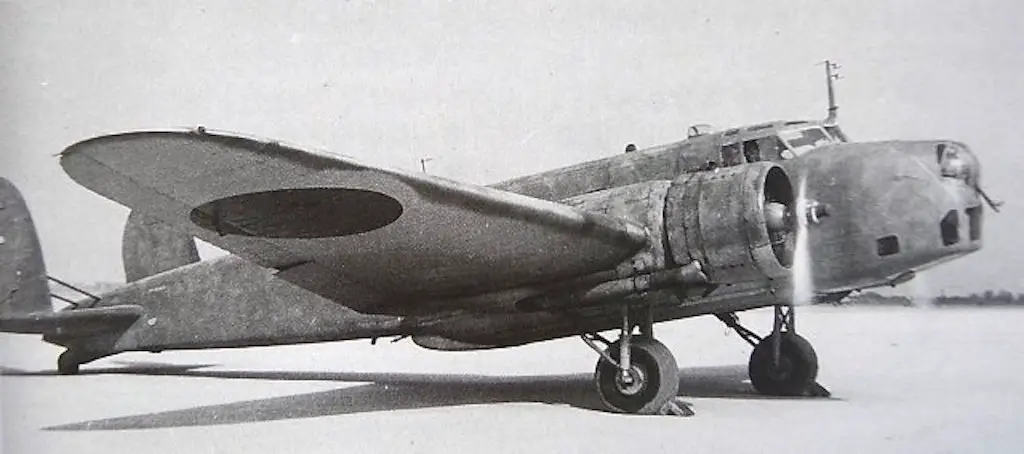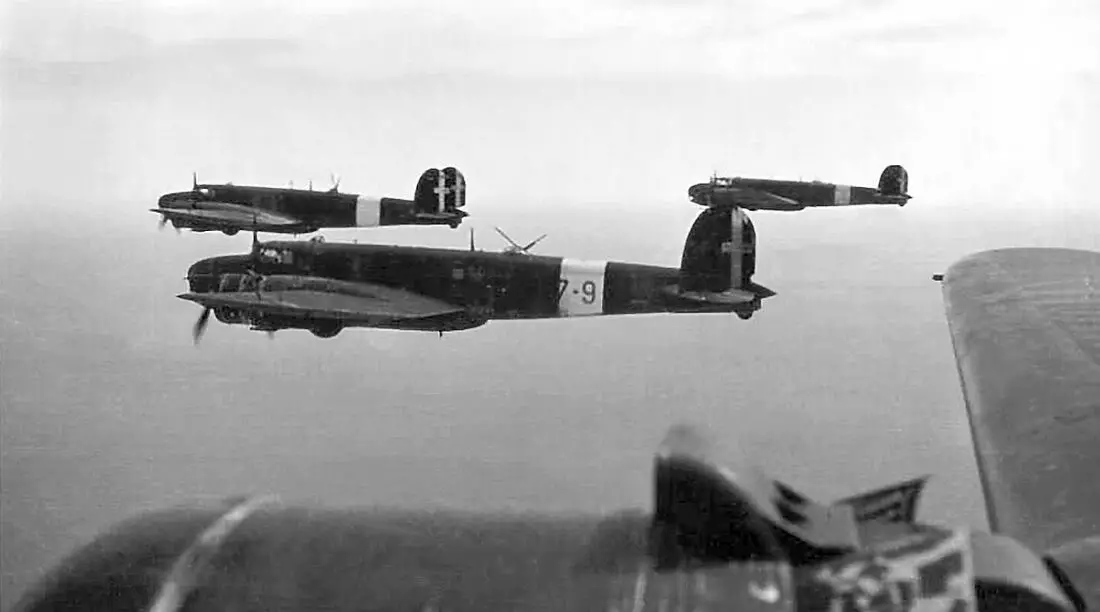Origin and Early Achievements
In the mid-1930s the engineer Celestino Rosatelli, father of the biplane fighters CR.1, R.20, CR.32 and (later) CR.42, developed a project for a double engine medium bomber of metal construction, mounting the engine Fiat A.80 RC.41. The new aircraft named Fiat BR.20 Cicogna.

Fiat Br.20 Cicogna.
BR. stood for Bombardiere Rosatelli. It first flew in February 1936 and had a quite modern profile for the standards of the 1930s. Impressed by the new Fiat bomber, the Regia Aeronautica ordered it into production.
In 1937, two modified Fiat BR.20s competed in a long-distance air race between Damascus-Paris, where they ended the race in 6th and 7th place. In 1939, another modified BR.20 established a speed record flying 4,500 km from Rome to Addis Ababa at an average speed of 404 km/h.
Spanish Civil War
The first operational use of the Fiat BR.20 occurred in 1937 as part of the Aviazione Legionaria, the Italian Expeditionary Corps supporting the Nationalist forces in Spain. The Aviazione Legionaria included 16 BR.20 planes in the mission They operated until the end of the hostilities in early 1939. When the Spanish Civil War concluded, all surviving BR.20s were handed over to the new Spanish state.
The BR.20 proved to be slightly inferior to SM.79 Sparviero, which formed the bulk of the bomber force of the Regia Aeronautica. The Sparviero was, in fact, more maneuverable and the third engine provided the Sparviero a superior performance that the Cicogna could not achieve.
Exports
In the same period, Japan purchased a group of 85 BR.20s which they employed in the war against China. These planes were meant to be “interim bombers” while the Japanese Air Force awaited the delivery of the new Ki-21 medium bomber. The Japanese developed a negative opinion of the Fiat BR.20, stating that its armament and operational range were not satisfactory. In addition, the BR.20 proved to be less effective and reliable when operating in harsh climate conditions.

A Fiat Br.20 used by Japanese forces.
When Italy entered World War Two in 1940 the Regia Aeronautica could count on 216 BR.20, 132 of which were operational. They participated in a bomber force consisting of SM.79s, SM.81s and CANT Z.1007.
French Front
The Fiat bombers entered into action on the night of the 12 June 1940 when 10 BR.20s from the 13° Stormo dropped bombs on Toulon hitting the harbor. This bomb run repeated a few days later. But this time French D.520 fighters intercepted the bombers and shot down two Cicogna.
Battle of Britain
The largest Fiat BR.20 operational deployment took place during the Battle of Britain when Mussolini sent an expeditionary air corps in support of the Luftwaffe.
On 10 September 1940, the Regia Aeronautica created the Corpo Aeronautico Italiano (CAI). It included 75 BR.20 from the 43°, 98°, and 99° bombing group. The Cicogna were supported by 50 Fiat CR.42 and 45 Fiat G.50 fighters. The redeployment in Belgium was a disaster and took more than a month to complete. The first bombing mission against Britain launched on 24 October.
The BR.20 bombers suffered greatly from the harsh climate conditions over the channel. Additionally, their defensive armament was insufficient against British fighters. Soon the CAI opted for night operations where enemy fighters were not an issue. However, the overall Italian contribution was insignificant. The Fiat bombers could do little to change the outcome of the Battle of Britain.
By January 1941, the CAI was repatriated with 20 bombers lost.
Other Fronts
The Fiat BR.20 bomber saw action on all fronts where Italian forces were engaged. Starting in 1940 they operated bombing missions over Malta and Greece. In April 1941 they were deployed in North Africa and used for tactical bombing missions. However, their age and limited production numbers led the Regia Aeronautica to progressively move the BR.20 from bombing to recognizance duties. They continued to perform recognizance duties until 1943.

BR.20 Bombers in flight.
A small group of BR.20s deployed to the Soviet Union as part of the expeditionary air corps in support of Italian troops in that theatre. These BR.20s were also only relegated to recognizance duties while the bulk of this air corps consisted of Macchi C.200 fighters.
Armistice
At the time of the armistice in September 1943, roughly 60 BR.20 were still in service with the Regia Aeronautica. Very few of them saw service with the Co-belligerent Air Force or the Republican National Air Force. The last surviving aircraft were scrapped in 1946. In 1944, the Croatian Air Force used three BR.20s as a training aircraft for bomber crews as they continued to fight alongside the Luftwaffe.
Production and Variants
Between 1936 and 1942, Italy built approximately 500 BR.20s. The Regia Aeronautica received several variants of the aircraft. The most common being the Fiat BR.20M which included an improved nose turret and an increased glass surface. In 1943, Italy produced 15 BR.20 “bis”. They mounted an improved defensive armament and the new A.82 RC.42 engines.
The Fiat BR.20 was indeed a modern aircraft for 1937 standards. Its successful use in the Spanish Civil War misled the Regia Aeronautica into thinking they could fight in a future European war. The limits of these aircraft, the rapid development of aircraft technology and antiquated doctrine soon proved them wrong.
Specifications
| Model | Fiat BR.20 |
|---|---|
| Crew | 5 |
| Powerplant | (2) Fiat A.80 R.C.41 1,000 HP Each |
| Maximum Speed | 270 mph (440 km/h) |
| Max Ceiling | 26,000 ft (8,000 m) |
| Range | 1,710 miles (2,750 km) |
| Length | 54.9 ft (16.68 m) |
| Height | 15.7 ft (4.75 m) |
| Weight | Empty: 14,330 lb (6,500 kg) Max: 22,267 lb (10,100 kg) |
| Wing Area | 800 Sq ft (74 m2) |
| Wingspan | 70.9 ft (21.56 m) |
| Armament | (3) 12.7 mm Breda SAFAT machine guns Bomb Load up to 3,530 lbs (1,600 kg) |
Sources
Angelucci E., Matricardi P., Aerei da combattimento della Seconda Guerra Mondiale (2001).
Sgarlato N., La Regia Aereonautica nella Seconda Guerra Mondiale (2000).